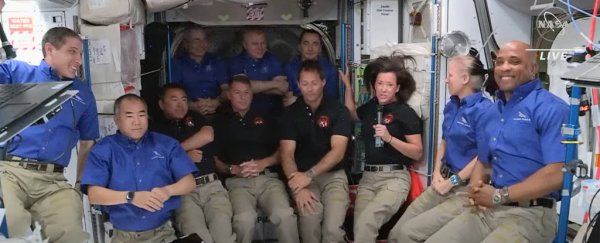A new international crew of astronauts, riding SpaceX's Crew Dragon capsule, has arrived at the International Space Station (ISS).
The astronauts – Shane Kimbrough and Megan McArthur of NASA, Akihiko Hoshide of the Japan Aerospace Exploration Agency, and Thomas Pesquet of the European Space Agency – launched from NASA's Kennedy Space Center in Florida early Friday morning.
Their mission, called Crew-2, is SpaceX's second full-length astronaut flight for NASA. Astronauts from the company's first flight, Crew-1, awaited them on the ISS.
The new arrivals orbited Earth for nearly 24 hours in their Crew Dragon spaceship. The capsule performed a series of automated maneuvers to dock to the ISS around 0915 UTC (5:15 am ET) on Saturday.
At about 7:45 am ET, Crew-2 floated in through the spaceship's hatch.
The Crew-1 astronauts took photos on their iPhones and iPads before embracing the Crew-2 astronauts – Shannon Walker, Victor Glover, Mike Hopkins, and Soichi Noguchi.
"Endeavour arriving!" Welcome to the @Space_Station, Crew-2!
— NASA (@NASA) April 24, 2021
Their arrival means there are now 11 humans aboard our orbiting laboratory, a number not seen since the space shuttle era. Hugs abound. pic.twitter.com/uSwW3JFl6K
"It is very exciting to have Crew-2 with us today," Walker said on a NASA live stream of a welcoming ceremony. "It's taken a tremendous amount of work from a lot of different teams to get us here," she continued.
Last week, Soyuz MS-18 transported two Russian cosmonauts and a NASA astronaut to the ISS. Now there will be 11 astronauts on the ISS for at least the next four days, as the two SpaceX crews overlap.
They're five beds short, but the good news is that you can set up a sleeping bag pretty much anywhere on the football-field-sized orbiting laboratory.
The SpaceX missions' commanders – Hopkins and Kimbrough – will sleep in their respective Crew Dragon capsules, which are named Resilience and Endeavour.
The other Crew-1 astronauts – Noguchi, Walker, and Glover – will sleep in the ISS gym, the Columbus laboratory module, and the airlock.
It's only temporary. The Crew-1 astronauts will return to Earth as early as Wednesday. When the time comes, they'll put on their spacesuits and climb into the Crew Dragon Resilience.
The spaceship will then undock from the ISS, push itself toward Earth, and plummet through the atmosphere. Parachutes should release, allowing the spaceship to drift to a splashdown off the coast of Florida.
The Crew-2 astronauts will stay on the ISS for about six months, maintaining the station, doing repairs, and conducting scientific research. They'll return to Earth with their own splashdown in autumn.
Getting more astronauts to the ISS was one of the motivating goals behind NASA's partnership with SpaceX.
In addition to being cheaper than Russian Soyuz flights, the Crew Dragon can fit one more astronaut than Soyuz. That means more capacity for space-station maintenance, technology development, and scientific experiments.
The Crew-2 astronauts will be doing all those things during their time on the ISS.
This isn't the largest group of people the space station has ever held – a record 13 people have been onboard together several times during crew changes and shuttle re-supplies, according to Space.com.
This article was originally published by Business Insider.
More from Business Insider:
